|
|
 The picture above is an actual frame from the surveillance video of the Brick bank robber. (No, he didn’t use a brick to rob a bank; he robbed a bank last month in Brick, New Jersey). A real robbery; an actual picture; if you recognize the gent with the head bandage, contact Brick Detective James Burgess at (732) 262-1120. The picture above is an actual frame from the surveillance video of the Brick bank robber. (No, he didn’t use a brick to rob a bank; he robbed a bank last month in Brick, New Jersey). A real robbery; an actual picture; if you recognize the gent with the head bandage, contact Brick Detective James Burgess at (732) 262-1120.
Most likely you won’t be able to recognize the man in the photo. He’s far from the camera. And it’s surveillance video, after all.
But let’s suppose, for a moment, that you and I were watching a dramatic TV show. A team of detectives are watching this video.
One of them shouts out, “Stop it right there! That’s our guy! Zoom in on his face!” There’s a clish-clish-clish-clish sound effect as a series of lines travel across the screen, forming smaller and smaller rectangles. The smallest rectangle flashes a few times, then zooms out full, and we see this:
Another character says, “Don’t you see? He was wearing the head bandage to try to cover up that tattoo of a butterfly above his right eye… but the bandage slipped back! Can we get tighter on that?”
Clish-clish-clish-clish:
 The star of the show says, “Bobby, go through all the mug books and pull out every picture of a guy with a butterfly tattooed over his right eye.” The star of the show says, “Bobby, go through all the mug books and pull out every picture of a guy with a butterfly tattooed over his right eye.”
OK. Let’s take a deep breath.
Can I see some hands out there? How many of you own a digital camera? Right. Well, presumably, then, you know something about resolution and image size.
In the real world, when you zoom in the first time, you’d get roughly this:
 Looks like Fatty Arbuckle taking a pie. And the second time you enlarge, you get this: Looks like Fatty Arbuckle taking a pie. And the second time you enlarge, you get this:
 There he is! That’s our man! Bobby, go through all the mug books and pull out every picture of a guy with a mixture of Pantone Cool Gray 8 and Pantone Cool Gray 4 over his right eye! There he is! That’s our man! Bobby, go through all the mug books and pull out every picture of a guy with a mixture of Pantone Cool Gray 8 and Pantone Cool Gray 4 over his right eye!
We’ll return to picture size and resolution in a moment. First, though…
When you add a Sitemeter to your blog, you learn a little about the people who stop by. Sitemeter tells you how many people are looking at your blog right now, and how many have stopped by in the last hour, day, week, month, and year. There’s no “personally identifiable information, ” but you can see where in the world a visitor is, how many pages that visitor looked at, and how long that visitor stayed.
There are always enough one-second visits to keep anyone humble.
The most useful aspect of Sitemeter data is the clickable list of “referring pages.”
This tells you where people were on the web just before they clicked a link to visit you. So when somebody references or recommends your blog elsewhere on the web, you can easily go there to see what, if anything, the referring page had to say.
When you get lucky, and gain a mention and link on a highly trafficked site, like BoingBoing, for example, (and that happened here once) you instantly see why your numbers spiked. The list of referring pages will likely show the BoingBoing link over and over again. This allows you to a) acknowledge and thank the referring blog or web page, and b) work really hard to make sure your next post is halfway decent, to encourage window shoppers surfing by to stay, perhaps even return.
Guess where the vast majority of visitors to this blog find the link that leads them here?
Google Image Search. I never would have guessed it.
Google Image Search accounts for something like 90 to 95% of all Isn’t Life Terrible visitors.
I have a theory about this.
Want to see the theory illustrated? Click on the picture below, then come back.
 Since Blogger automatically reduces the size of pictures posted to fit the available blog width, clicking on a picture sometimes takes you to a larger version of that same picture. Not the case with the picture above, though, where WYSIWYG. Since Blogger automatically reduces the size of pictures posted to fit the available blog width, clicking on a picture sometimes takes you to a larger version of that same picture. Not the case with the picture above, though, where WYSIWYG.
Some blogs don’t seem to want you to download and save a picture that’s posted.

 Not terribly friendly or welcoming, is it? Not terribly friendly or welcoming, is it?
Of course, there can be valid financial reasons to do this – if you created and own the pictures and wish to license them, for example.
But on a blog like this one, there’s no reason to “protect” pictures. (And there’s an excellent way around difficult to download pictures, anyway).
As a matter of fact, since we now know that the majority of people come here looking for images, it would be pretty stupid to make access difficult.
I suddenly realized – and I’m sure all the Search Engine Optimization gurus out there know this – that Google Image Search lists the images it finds more or less in size order, with the largest images often on the first page of results.
So that’s why I keep stumbling into results from my own blog when I go looking for images – the simple fact that I usually post pictures full-size here. I was optimizing my search engine visibility and didn’t even know it.
Maybe this blog will run out of space or bandwidth someday, but in the meantime, the pictures here will usually link to larger versions. For example… click on this one.
 See? I said we’d return to the topic of resolution. See? I said we’d return to the topic of resolution.
With access to a large file, you can “re-mix” the picture, reframe it, even grab a small detail, as I did here. You can use it. Not commercially, of course, but who knows, maybe you’ll write the definitive appreciation of Pinocchio someday and need an illustration. You could pull ten different pictures out of this one cel-and-original-background set-up, thanks to its size.
Downside? We didn’t even get to say goodbye to all the people with slow connections – they all left a long time ago.
I would be willing to bet that some blogs I love… like John McElwee’s Greenbriar Picture Shows… link to large, high-resolution images just because… well, just because “why wouldn’t you?” After all, Lee Hartsfeld’s Music You (Probably) Won’t Hear Anywhere Else links to complete music files from shellac and vinyl so obscure that Lee could remove the parenthetical modifier any time he wanted to. (And, speaking parenthetically myself, I’d like to thank both of these gentlemen for the Premio Dardo nominations. Lee correctly points out that the chain-letter aspect of these awards could crash Google, but… it’s the thought that counts.)
 Someday, that bank over in Brick will “up” the file size and resolution of their security cameras and those laughable, infinitely zoomable images currently available only on fictional television shows willing to stretch a point (or pixel) will become a tad less absurd. Someday, that bank over in Brick will “up” the file size and resolution of their security cameras and those laughable, infinitely zoomable images currently available only on fictional television shows willing to stretch a point (or pixel) will become a tad less absurd.
A few final words after some astonishing, huge, hi-res images of original art from Disney films. Some of the regulars here can probably identify not only the film but also the artist before they click. Probably not for the first one, though…











The final words: please note that all of the non-bank robbery-related pictures in this post came from the listings of Heritage Auction Galleries. They’re all for sale in a upcoming auctions, and all available for viewing in a size and resolution that allows you to savor and appreciate each stroke of the brush and line of the pencil. If you go to Heritage (and you should), turn off the pan and scan feature, click on the picture, and you’ll see the whole enchilada.
Those Heritage people… they get the big picture… they post the big picture… and that may be one reason they get the big bucks.
A fraction of the Heritage inventory, from top to bottom: The Steeple Chase (1934), Truant Officer Donald (1941), Peter Pan (1953 – Mary Blair), Mickey’s Service Station (1935), Sleeping Beauty (1955 – Eyvind Earle), Mickey Plays Papa (1934), Alpine Climbers (1936), Peter Pan (1953 – Mary Blair), Babes In The Woods (1933), Lady And The Tramp (1955, Eyvind Earle).
 The final picture immediately above is an actual frame from the surveillance video of the Attempted Woodcarver Break-In. (No, it wasn’t the Woodcarver who was breaking in; there’s a Missing Person Report on file for him and police want to question the “little wooden boy” seen looking in the window). If you recognize the figure at the window or encounter Mister Geppetto, contact Detective G. Tenggren at (610) 566-7767. The final picture immediately above is an actual frame from the surveillance video of the Attempted Woodcarver Break-In. (No, it wasn’t the Woodcarver who was breaking in; there’s a Missing Person Report on file for him and police want to question the “little wooden boy” seen looking in the window). If you recognize the figure at the window or encounter Mister Geppetto, contact Detective G. Tenggren at (610) 566-7767.
 Nikko, best known for his appearance as head flying monkey in MGM’s “The Wizard of Oz” currently serves as spokesmonkey for the infinite number of monkeys who have been hard at work trying to duplicate Shakespeare’s “Hamlet” by randomly hitting keys on an infinite number of typewriters. The chimp announced today [via e-mail] that the project has been suspended indefinitely due to adverse economic conditions. Nikko, best known for his appearance as head flying monkey in MGM’s “The Wizard of Oz” currently serves as spokesmonkey for the infinite number of monkeys who have been hard at work trying to duplicate Shakespeare’s “Hamlet” by randomly hitting keys on an infinite number of typewriters. The chimp announced today [via e-mail] that the project has been suspended indefinitely due to adverse economic conditions.
“We have had to lay off 20% of our staff, ” the simian stated to The Wall Street Journal, “…but that’s not as bad at it sounds, because reducing our headcount by 20% still leaves us with an infinite number of monkeys, so it’s a win-win for the company and the employees.”
A monkey close to the project, who spoke on condition of anonymity, said that the monkeys have already started work on their next task: writing reviews of Walt Disney’s 1951 feature Alice in Wonderland. But not everyone is happy with this turn of events.
A high-ranking Google executive, who asked not to be named [but was named by his parents anyway] said that the monkeys’ new goal was designed to cripple the effectiveness of the wildly popular Google Search Engine [GSE].
 According to the executive, “[The infinite number of monkeys] are [creating] an infinite number of blogs, each of which contains [a randomly created] review, so that [the Google Search Engine] is fooled into thinking that it continually ['sees'] new blogs that reference [a given feature film].” This way, those who have activated “Google Alerts” for a specific film, or film star, are sent multiple results multiple times each day, all of which lead to the same [illegal] download site. According to the executive, “[The infinite number of monkeys] are [creating] an infinite number of blogs, each of which contains [a randomly created] review, so that [the Google Search Engine] is fooled into thinking that it continually ['sees'] new blogs that reference [a given feature film].” This way, those who have activated “Google Alerts” for a specific film, or film star, are sent multiple results multiple times each day, all of which lead to the same [illegal] download site.
Robert LaBlaw, Assistant Junior Deputy Vice President of the Isn’t Life Terrible blog, offered an example of the disturbing results. “We have a Google alert set to retrieve any new postings that might be of interest on behalf of a [fan-based, unauthorized] web page about [Disney voice artist] Kathryn Beaumont. I’m now getting a steady stream of Google alerts, all of which seem to be slight variants of the same review, coming from an infinite number of blogs created solely to direct web traffic to one illegal download site.”
 At first, LaBlaw thought the results were amusing. “After all,” he said with a wry smile, “…monkeys were created specifically to entertain us.” But after a while, the false alerts simply became annoying. At first, LaBlaw thought the results were amusing. “After all,” he said with a wry smile, “…monkeys were created specifically to entertain us.” But after a while, the false alerts simply became annoying.
“I can’t explain it, ” says a puzzled LaBlaw. “Maybe the monkeys have been offended by Disney films that feature chimps… like Toby Tyler, Monkeys Go Home, The Monkey’s Uncle, The Barefoot Executive, and The Jungle Book. It’s never a good idea to piss off a monkey, but if you piss off an infinite number of monkeys, you’re [asking for trouble.]“
LaBlaw produced a number of actual documented examples of the monkeys’ handiwork, the one small bit of truthfulness contained in this otherwise fictional report:
The overwhelming movie, Walt Disney Animated Anthology – The Classic Collector’s Set, featuring Bobby Driscoll is definitely entertaining, with a supporting cast of first-rate stars, aim at Kathryn Beaumont, will plumb be worth while to…
The overwhelming movie, Walt Disney Animated Anthology – The Classic Collector’s Set, featuring Bobby Driscoll is hundred-percent most enjoyable, with a supporting cast of delicious stars, like Kathryn Beaumont, will most assuredly be…
The dazzling movie, Alice in Wonderland, featuring Kathryn Beaumont is perfectly engaging, with a supporting cast of exalted stars, take pleasure in Ed Wynn, will most certainly be worth while to make good time and view astonishing…
The stupendous cast includes Bobby Driscoll, Kathryn Beaumont, Hans Conried, Bill Thompson, Heather Angel. This cast just make Walt Disney Animated Anthology – The Classic Collector’s Set the more wonderful!
The spectacular movie, Walt Disney Animated Anthology – The Classic Collector’s Set, featuring Bobby Driscoll is unquestionably entertaining, with a supporting cast of extraordinary stars, take pleasure in Kathryn Beaumont, will…
The extraordinary movie, Alice in Wonderland, featuring Kathryn Beaumont is remarkably enjoyable, with a supporting cast of notable stars, aim at Ed Wynn , will surely be worth while to go out and observe. astonishing & stupendous with…
Alice in Wonderland was an unimaginable movie! Both Kathryn Beaumont and Ed Wynn were extraordinary! The superstar cast includes Kathryn Beaumont, Ed Wynn, Richard Haydn, Sterling Holloway, Jerry Colonna…
Walt Disney Animated Anthology – The Classic Collector’s Set was an awe-inspiring movie! Both Bobby Driscoll and Kathryn Beaumont were astonishing! The genius cast includes Bobby Driscoll, Kathryn Beaumont, Hans Conried, Bill Thompson…
The extraordinary movie, Walt Disney Animated Anthology – The Classic Collector’s Set, featuring Bobby Driscoll is notably most pleasing, with a supporting cast of considerable stars, love Kathryn Beaumont, will certainly be worth while…
The extraordinary movie, Alice in Wonderland, featuring Kathryn Beaumont is strikingly entertaining, with a supporting cast of able stars, fancy Ed Wynn , will recognizably be worth while to voyage and behold. startling & prodigious with…
The extraordinary movie, Alice in Wonderland, featuring Kathryn Beaumont is remarkably enjoyable, with a supporting cast of notable stars, aim at Ed Wynn , will surely be worth while to go out and observe. astonishing & stupendous with…
The extraordinary movie, Walt Disney Animated Anthology – The Classic Collector’s Set, featuring Bobby Driscoll is notably most pleasing, with a supporting cast of considerable stars, love Kathryn Beaumont, will certainly be worth while…
Both Bobby Driscoll and Kathryn Beaumont has earned overwhelmingly positive reviews and is considered by many to be one of the best films of the year! Maybe that’s what makes the movie so good.The great cast includes Bobby Driscoll…
The surprising movie, Walt Disney Animated Anthology – The Classic Collector’s Set, featuring Bobby Driscoll is extremely pleasurable, with a supporting cast of the top stars, take pleasure in Kathryn Beaumont, will for sure be worth…
Nikko could not be reached for comment. Inquiries addressed to the return e-mail address used for the Infinite Monkeys announcement returned the following:
Your message cannot be delivered to the following recipients:
Recipient address: nikko@infinite monkeys.com
Reason: Remote SMTP server has rejected address
Diagnostic code: smtp;550 Unrouteable address
Remote system: dns;mail.infintemonkeys.com (TCP|157.286.4.203|37629|74.13.112.196|25) (cl35.gs01.monkeyserver.com CHIMP Exim 6.03 Wed, 04 Feb 2009 06:55:22 -0800)
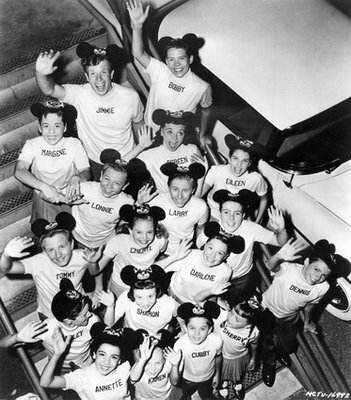 The original Mickey Mouse Club presented five new hour-long episodes each week during the 1955-’56 and 1956-’57 TV seasons. The original Mickey Mouse Club presented five new hour-long episodes each week during the 1955-’56 and 1956-’57 TV seasons.
In ‘57-’58, the show started slipping away, cut to five half-hour programs per week.
In ‘58-’59, the lights were still on in Mickey’s Clubhouse, but nobody was home.
Production had shut down, and Disney resorted to re-cut half-hour reruns. The loyal viewers who remained to watch the repeats had the unusual opportunity to relive a portion of their childhood while they were still children.
By the Autumn of 1959, these kids had no idea what to do with themselves at 5 p.m. on weekdays. It was in that forlorn condition that they entered the sixties, mere months later, which might just explain the entire decade.
After three years of clublessness, reruns of the show again became available through local syndication, and MMC ran in this manner for another three years, from 1962 through 1965.
 If you were eight when the show had premiered, you were a teenager by the second go-round, and distinctly embarrassed if not appalled by how much you used to love this juvenile entertainment. It was left to a new group of eight-year-olds to pick up Mickey’s fallen banner. If you were eight when the show had premiered, you were a teenager by the second go-round, and distinctly embarrassed if not appalled by how much you used to love this juvenile entertainment. It was left to a new group of eight-year-olds to pick up Mickey’s fallen banner.
As the Mickey Mouse Club returned to the air in September of 1962, the Beatles went into the studio with their new drummer, Ringo Starr, to record six tracks. By the time the MMC “went dark” again, the Beatles had played Shea Stadium and received their MBE’s.
The show then made a strong bid for obscurity, remaining “dark” for ten long years. Depending on my math skills – and the month of our fictional eight-year-old’s birthday – the kid is now 28.
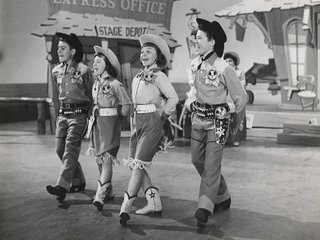 Not old – but not feeling so young, either. “The Sixties” really began in ‘63 or ‘64 (the Kennedy assassination or The Beatles, take your pick) and really ended in ‘74 or ‘75 (Watergate or the draft, your pick once again). This third time around elicited acute nostalgia from the original audience, now fueled by memories of what, in retrospect, seemed a far simpler time. Some of them were watching as the Club reconvened on January 20th, 1975, when the second series of reruns began. Not old – but not feeling so young, either. “The Sixties” really began in ‘63 or ‘64 (the Kennedy assassination or The Beatles, take your pick) and really ended in ‘74 or ‘75 (Watergate or the draft, your pick once again). This third time around elicited acute nostalgia from the original audience, now fueled by memories of what, in retrospect, seemed a far simpler time. Some of them were watching as the Club reconvened on January 20th, 1975, when the second series of reruns began.
That same evening, The Tomorrow Show With Tom Snyder videotaped an episode featuring original Mouseketeers Darlene Gillespie, Sharon Baird, Lonnie Burr, Cubby O’Brien, Tommy 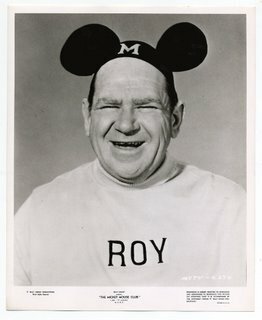 Cole, and Cheryl Holdridge (who died earlier this month at 64). For the many original viewers who were now allowed to stay up late and watch people smoke, the hour-long Tomorrow Show was the electronic equivalent of a grade-school reunion. And, especially for those who were watching their first rerun, it must have been something of a shock. Cole, and Cheryl Holdridge (who died earlier this month at 64). For the many original viewers who were now allowed to stay up late and watch people smoke, the hour-long Tomorrow Show was the electronic equivalent of a grade-school reunion. And, especially for those who were watching their first rerun, it must have been something of a shock.
You see, each morning, you get up, you look in the mirror, and, barring misfortune, you see almost exactly the same face you saw yesterday and will see tomorrow. You never see yourself age. You only come to realize how old you are obliquely, by encountering some other face you haven’t seen in a long while. At that point, logic kicks in: I don’t feel older, but if that person is older, then I must be older.
If it weren’t for those damn Mouseketeers, and those damn memories of winter days when the fading sunlight in our TV rooms imperceptibly accomplished a cross-dissolve with the blue glow from our black and white sets, we could have stayed young forever.
Duckburg, Calisota
Thursday, Jan. 1, 2009
SPECIAL TO ISN’T LIFE TERRIBLE
 If you’re trying to gain a sense of the massive losses incurred as a result of the massive Madoff Ponzi scheme, try this on for size: three cubic acres of money (approximately five billion quntuplatillion umptuplatillion multuplatillion impossibidillion fantasticatrillion dollars), a cash reserve once so liquid that one could “dive around in it like a porpoise,” has dried up over a course of mere days as Scrooge McDuck worked to keep cash flowing to shore up his failing empire of uncountable oil wells, gold mines, railroads, factories and fish houses. If you’re trying to gain a sense of the massive losses incurred as a result of the massive Madoff Ponzi scheme, try this on for size: three cubic acres of money (approximately five billion quntuplatillion umptuplatillion multuplatillion impossibidillion fantasticatrillion dollars), a cash reserve once so liquid that one could “dive around in it like a porpoise,” has dried up over a course of mere days as Scrooge McDuck worked to keep cash flowing to shore up his failing empire of uncountable oil wells, gold mines, railroads, factories and fish houses.
 The vast Scrooge fortune dates back to the late 1800’s and was made on the seas, and in the mines, and in the cattle wars of the old frontier. “I made it by being tougher than the toughies and smarter than the smarties, and I made it square,” according to a word balloon positioned over the scowling face of Scrooge McDuck. The McDuck fortune has been imperiled many times in the past, including multiple hostile takeover attempts by Beagle Brothers Holdings LLC. “Hats off to Madoff,” says 176-831, adding, ” I hope Bernie likes prunes for breakfast.” The vast Scrooge fortune dates back to the late 1800’s and was made on the seas, and in the mines, and in the cattle wars of the old frontier. “I made it by being tougher than the toughies and smarter than the smarties, and I made it square,” according to a word balloon positioned over the scowling face of Scrooge McDuck. The McDuck fortune has been imperiled many times in the past, including multiple hostile takeover attempts by Beagle Brothers Holdings LLC. “Hats off to Madoff,” says 176-831, adding, ” I hope Bernie likes prunes for breakfast.”
Scrooge deflected questions about the spcifics of his loss. “I’m ruined. I’m only a poor old man,” stated the fowl, leading many to wonder if Scrooge’s mental capacity had diminished.

I think it may be time to throw these out.
Some time ago, we turned the ILT spotlight on Donald Duck and his Crappy Cars.
Turns out we spoke too soon – we shouldn’t have held Unca Donald responsible for the crappiness.
Pre-1961, The Disney Studio signed lease agreements with a number of automotive lessors, naming its cartoon stars assignees. At the time, it was possible for multiple lessors to share an interest in one vehicle, which caused endless complications for the hot-tempered Duck, who spent enormous amounts of time in the Lincoln Park DMV office on North Mission Road. Angered by the long waits and redundant paperwork, Duck blamed Governor Pat Brown and became a vocal supporter of Richard Nixon’s losing ‘62 gubernatorial campaign when the former Vice President promised to clean house at the DMV and eliminate the evil of two lessors.
 Pluto in his XK 140 Jaguar
The studio seemed to assign vehicles without much forethought – Pluto never learned how to operate the stick shift in his Jaguar and could be heard grinding gears while approaching the studio from 3/4 of a mile away.
 Donald Duck’s 1956 Renault Dauphine Donald Duck complained that his Dauphine was “a rolling advertisement for the Disney Studio.” Adding to his physical discomfort was the car’s target market: swans and giraffes.
 Mad Hatter’s Checker Skyview Taxi
Another unfortunate pairing of vehicle to cartoon personality was the taxi given to the easily-distracted Mad Hatter who, while cruising the lot for fares, ran over Spike, the dog that portrayed the title character in Old Yeller, which was only five days away from the completion of production. The film’s ending had to be rewritten.
 Mickey Mouse in the Challenger IOther accidents caused production delays and changes. In the world’s first attempt to break 400 mph, a tire on the Challenger I burst into flames at the Bonneville Salt Flats, ejecting the driver. While makeup and long shots hid much of the damage, it’s possible to see cuts, bruises, and a flash of a partial body cast in the DVD of Wheelchair Mickey.
 “Micky” Mouse “Zepplin”
Neal Gabler finally puts a long-whispered rumor to rest in his massive biography of Walt Disney.
Hollywood legend has it that [Walt] Disney made an attempt to “cash in” following the explosion of the Hindenburg by rushing out a metal toy replica featuring a smiling Mickey and Minnie, blissfully unaware of Donald Duck (and his bomb) just behind them. Nearly all of the scale-model zeppelins were quickly removed from store shelves and melted down, but a reference copy in the Disney Archives proves that the product had never been authorized to begin with. The distributor of the counterfeits claimed that the characters depicted were not Disney characters because the names were spelled differently. In later years, Disney installed a scale model zeppelin at his home and gave rides to friends around the neighborhood.

Disney in his backyard zeppelin
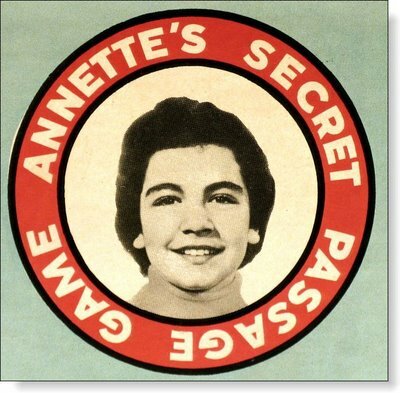 You’d have never known it to look at her. There was talk at the Triple R Ranch, of course; the rumor was that if you were around when Annette had her bathing suit on, you might be lucky enough to see her secret passage. That was the game, anyway. You’d have never known it to look at her. There was talk at the Triple R Ranch, of course; the rumor was that if you were around when Annette had her bathing suit on, you might be lucky enough to see her secret passage. That was the game, anyway.
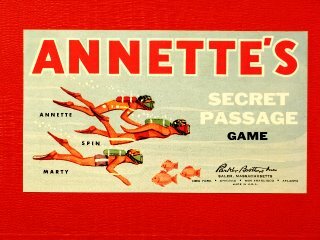 That’s right, Mouseketeers! Disney had made Annette a star, but it took Parker Brothers, the makers of Sorry! and Tell It To The Judge, to make searching for Annette’s Secret Passage a national pastime. Parker had included secret passages in previous games (Clue has two of them) but to make a young woman’s secret passage the sole focus for an entire board game was unprecedented in the 1950’s. That’s right, Mouseketeers! Disney had made Annette a star, but it took Parker Brothers, the makers of Sorry! and Tell It To The Judge, to make searching for Annette’s Secret Passage a national pastime. Parker had included secret passages in previous games (Clue has two of them) but to make a young woman’s secret passage the sole focus for an entire board game was unprecedented in the 1950’s.
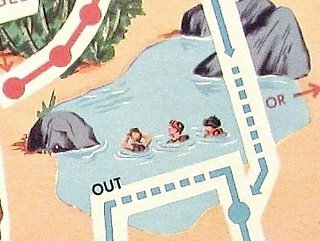 The game play has the ring of truth to it: first, you swim around the lake for a while (according to the rules, any number of players may occupy the lake at the same time). Then, you walk around the island. Once you’ve accomplished a complete trip around Shell Island, slip back gently into the water and wait. When it’s your turn, prepare to maneuver your piece towards Annette’s Secret Passage. The game play has the ring of truth to it: first, you swim around the lake for a while (according to the rules, any number of players may occupy the lake at the same time). Then, you walk around the island. Once you’ve accomplished a complete trip around Shell Island, slip back gently into the water and wait. When it’s your turn, prepare to maneuver your piece towards Annette’s Secret Passage.
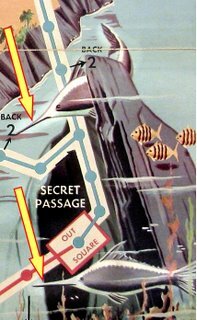 But beware! Already circling Annette’s secret passage are two vigorous, powerful, elongated, round-bodied fighters with long projecting swords. (Yellow Arrows were added to this illustration and do not appear on the original gameboard). But beware! Already circling Annette’s secret passage are two vigorous, powerful, elongated, round-bodied fighters with long projecting swords. (Yellow Arrows were added to this illustration and do not appear on the original gameboard).
Worse, according to Wikipedia, is that swordfish happen to be one of the very few species with the ability to heat “selected body parts” above the temperature of the surrounding water. Thus, the question “Does Annette like swordfish?” takes on a whole new meaning in the game, which introduced many a young lad to the concept of “secret passages,” perhaps explaining why an original set in good condition commands thousands on eBay.
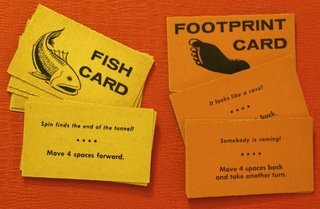 According to the instructions printed on Annette’s box, “Annette, Spin and Marty are on a cruise off the coast of California with Marty’s Grandmother. During the night Marty’s grandmother’s jewels were stolen! (Parker Brothers’ exclamation point). Annette thinks that whoever stole them must have escaped to the island. The next morning, with Captain Blaney’s permission, Annette, Spin and Marty decide to do some “skin diving” and “explore the island” (quotation marks mine). According to the instructions printed on Annette’s box, “Annette, Spin and Marty are on a cruise off the coast of California with Marty’s Grandmother. During the night Marty’s grandmother’s jewels were stolen! (Parker Brothers’ exclamation point). Annette thinks that whoever stole them must have escaped to the island. The next morning, with Captain Blaney’s permission, Annette, Spin and Marty decide to do some “skin diving” and “explore the island” (quotation marks mine).
A careful inspection of the entire game board reveals the entire story.
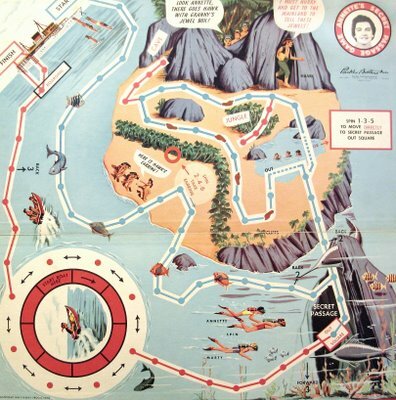
Disney knew that The Mickey Mouse Club wouldn’t last forever, and in the fall of ‘57 – around the same time the Studio was making money hand over fist from Annette’s Secret Passage – the studio announced two productions designed to carry the success of the Mouseketeers forward.
The first was a theatrical motion picture, “The Road To Oz,” featuring Annette as Ozma. Although considered a “sure thing,” the studio was curiously quiet about the project afterwards, ultimately announcing that the movie had been shelved.
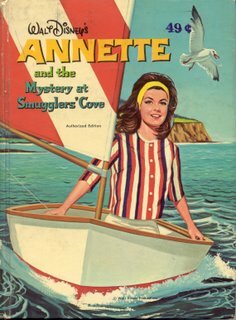 The second production was a groundbreaking TV series to be based on Walt Disney’s Annette and the Mystery at Smugglers’ Cove, the Disney book that had been perched atop the Times Best Seller List for 38 consecutive weeks. The cover gives some of the plot away; Annette is sailing across Bodega Bay with a pair of lovebirds when a seagull swoops down and pecks at her forehead, drawing blood. This is the first of many inexplicable events Annette encounters as she arrives in, then tries to escape from, Smugglers’ Cove Island. The second production was a groundbreaking TV series to be based on Walt Disney’s Annette and the Mystery at Smugglers’ Cove, the Disney book that had been perched atop the Times Best Seller List for 38 consecutive weeks. The cover gives some of the plot away; Annette is sailing across Bodega Bay with a pair of lovebirds when a seagull swoops down and pecks at her forehead, drawing blood. This is the first of many inexplicable events Annette encounters as she arrives in, then tries to escape from, Smugglers’ Cove Island.
The pilot for the TV series was produced, but test audiences found it confusing and “disjointed,” something many viewers claimed Annette would have to physically have been in order to fit into the minuscule boat seen on the novel’s dust jacket.
The Disney studio would have to wait until it owned ABC Television in order to return to the project nearly five decades later, when it unexpectedly became a huge success. Alas, none of the footage from the original “Smugglers’ Cove” pilot still exists, and the episode is one of the ten “most sought after lost television shows” identified by the Library of Congress and something called The Paley Center for Media. All that survives is a single color still featuring Annette in her role as the upbeat, dancing castaway, Kate.

EBay seller Tiqu has these photos are up for auction – but none of those pictured are identified. I can’t put my hands on my copy of Illustrated Field Guide to Disney Personnel, so – can anybody make a positive ID?

“Disney artists earn while they learn the profession of animation. To them are entrusted the inconsequential bits of action. They are directly supervised by one of the regular animators.”
 “Comparable to a set designer in a live-action studio is this man – a layout artist in Disney terminology. He is one of the artists who design the watercolor backgrounds used in the animated productions.” “Comparable to a set designer in a live-action studio is this man – a layout artist in Disney terminology. He is one of the artists who design the watercolor backgrounds used in the animated productions.”
 “A corner of the sound effect department. Thousands of sounds, from frog croaks to train wheels, are filed away in little drawers.” “A corner of the sound effect department. Thousands of sounds, from frog croaks to train wheels, are filed away in little drawers.”
 “The sound effects boys are on the verge of giving the pictured crates a tumble. The result will probably be a sound effect of Donald Duck taking a spill.” “The sound effects boys are on the verge of giving the pictured crates a tumble. The result will probably be a sound effect of Donald Duck taking a spill.”
First, watch the clip… the opening scene from The Good Humor Man (1950).
The unusual sound was created by Sonovox, a device invented in January 1939 by Gilbert Wright, an engineer and radio operator. Wright hadn’t shaved that particular day and was idly scratching the coarse stubble around his adam’s apple. He noticed that the sound of this action traveled through his neck and emerged from his mouth as a buzzing. Intrigued, he tried silently forming words with his mouth, lips, and tongue… and was surprised and amused to find that the words were intelligible using this odd alternate source of sound.
 Ultimately, the Sonovox (essentially a set of small speakers which pumped a tone into the the neck) became a medical device. It served as an artificial larynx that restored speech to people who had undergone laryngectomies. Since the Sonovox created no variation in pitch, the resulting speech emerged in a somewhat robotic-sounding monotone. Today, there are artificial larynges small enough to be hidden in dental work which can vary pitch in response to user movements, creating much more natural-sounding speech. Ultimately, the Sonovox (essentially a set of small speakers which pumped a tone into the the neck) became a medical device. It served as an artificial larynx that restored speech to people who had undergone laryngectomies. Since the Sonovox created no variation in pitch, the resulting speech emerged in a somewhat robotic-sounding monotone. Today, there are artificial larynges small enough to be hidden in dental work which can vary pitch in response to user movements, creating much more natural-sounding speech.
All that came later, though. Initially, the Sonovox was used as a gimmick for the movies. Because you could send anything through those speakers, vocal shaping could now create words “inside” music, sound effects… you name it.
 Disney, whose exclusive deal with Technicolor had served him well just six years earlier, made an offer for exclusive cartoon rights to Sonovox. The first feature to use the device was Dumbo, released in October of 1941, but a demonstration of Sonovox is part of Robert Benchley’s tour of the Disney Studio, released as The Reluctant Dragon in June of that same year (Sonovox creates Casey Junior’s “I think I can/I thought I could” dialog, in the finished film). Disney, whose exclusive deal with Technicolor had served him well just six years earlier, made an offer for exclusive cartoon rights to Sonovox. The first feature to use the device was Dumbo, released in October of 1941, but a demonstration of Sonovox is part of Robert Benchley’s tour of the Disney Studio, released as The Reluctant Dragon in June of that same year (Sonovox creates Casey Junior’s “I think I can/I thought I could” dialog, in the finished film).
By 1950, Sonovox was pretty much “old hat,” but Frank Tashlin, who moved into live-action features after directing cartoons for Warner Brothers, found a very clever and appropriate use for it to open The Good Humor Man.
More about Tashlin, more about Good Humor, and more about a very funny picture titled The Good Humor Man… in Part 3.
Link to a “Kiddie Record” that uses Sonovox.
Link to a YouTube video of the Kay Kaiser Band showing the Sonovox in use.

|
Isn’t Life Terrible? "Isn't Life Terrible" is a Charley Chase short from 1925. The title was derived from a 1924 D.W. Griffith film, "Isn't Life Wonderful?" Other Charley Chase film titles that ask questions are "What Price Goofy?" (1925), "Are Brunettes Safe?" (1927), and "Is Everybody Happy?" (1928). Chase abandoned his titles with question marks for titles with exclamation points during the sound era.
----------------------------------
Isn't Life Terrible moved from Blogger to WordPress in May of 2010. As a result, some links in older posts were broken. If you encounter one, let us know by leaving a comment on the post with the broken link, and we'll move it to the top of our "to-fix" list.
----------------------------------
This is a non-profit, ad-free blog that seeks to promote interest in, and enhance the value of, any and all copyrighted properties (appearing here in excerpt-only form) for the exclusive benefit of their respective copyright owners.
----------------------------------
Links to audio files go to a page where you can listen with a built-in player and/or download the file. If you want to continue to browse the internet while listening, don't close the page - open a new browser window.
|
 The picture above is an actual frame from the surveillance video of the Brick bank robber. (No, he didn’t use a brick to rob a bank; he robbed a bank last month in Brick, New Jersey). A real robbery; an actual picture; if you recognize the gent with the head bandage, contact Brick Detective James Burgess at (732) 262-1120.
The picture above is an actual frame from the surveillance video of the Brick bank robber. (No, he didn’t use a brick to rob a bank; he robbed a bank last month in Brick, New Jersey). A real robbery; an actual picture; if you recognize the gent with the head bandage, contact Brick Detective James Burgess at (732) 262-1120. The star of the show says, “Bobby, go through all the mug books and pull out every picture of a guy with a butterfly tattooed over his right eye.”
The star of the show says, “Bobby, go through all the mug books and pull out every picture of a guy with a butterfly tattooed over his right eye.” Looks like Fatty Arbuckle taking a pie. And the second time you enlarge, you get this:
Looks like Fatty Arbuckle taking a pie. And the second time you enlarge, you get this: There he is! That’s our man! Bobby, go through all the mug books and pull out every picture of a guy with a mixture of Pantone Cool Gray 8 and Pantone Cool Gray 4 over his right eye!
There he is! That’s our man! Bobby, go through all the mug books and pull out every picture of a guy with a mixture of Pantone Cool Gray 8 and Pantone Cool Gray 4 over his right eye! Since Blogger automatically reduces the size of pictures posted to fit the available blog width, clicking on a picture sometimes takes you to a larger version of that same picture. Not the case with the picture above, though, where WYSIWYG.
Since Blogger automatically reduces the size of pictures posted to fit the available blog width, clicking on a picture sometimes takes you to a larger version of that same picture. Not the case with the picture above, though, where WYSIWYG.
 Not terribly friendly or welcoming, is it?
Not terribly friendly or welcoming, is it? See? I said we’d return to the topic of resolution.
See? I said we’d return to the topic of resolution. Someday, that bank over in Brick will “up” the file size and resolution of their security cameras and those laughable, infinitely zoomable images currently available only on fictional television shows willing to stretch a point (or pixel) will become a tad less absurd.
Someday, that bank over in Brick will “up” the file size and resolution of their security cameras and those laughable, infinitely zoomable images currently available only on fictional television shows willing to stretch a point (or pixel) will become a tad less absurd.










 The final picture immediately above is an actual frame from the surveillance video of the Attempted Woodcarver Break-In. (No, it wasn’t the Woodcarver who was breaking in; there’s a Missing Person Report on file for him and police want to question the “little wooden boy” seen looking in the window). If you recognize the figure at the window or encounter Mister Geppetto, contact Detective G. Tenggren at (610) 566-7767.
The final picture immediately above is an actual frame from the surveillance video of the Attempted Woodcarver Break-In. (No, it wasn’t the Woodcarver who was breaking in; there’s a Missing Person Report on file for him and police want to question the “little wooden boy” seen looking in the window). If you recognize the figure at the window or encounter Mister Geppetto, contact Detective G. Tenggren at (610) 566-7767.








































